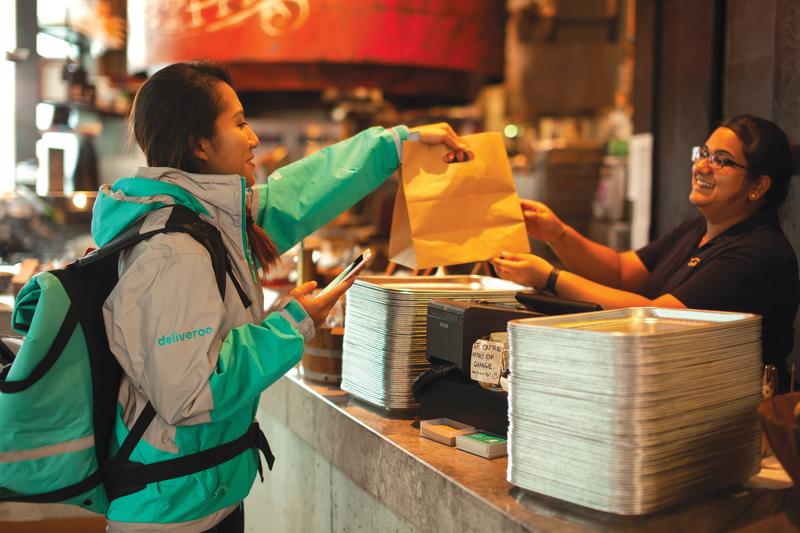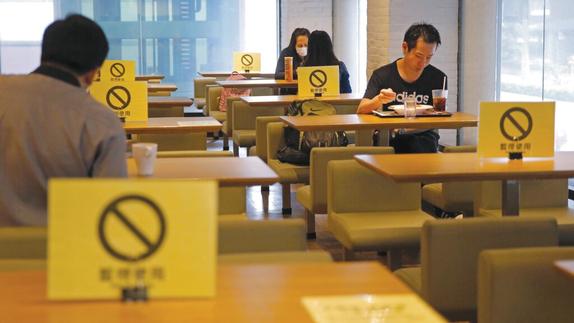The demise of many eateries due to the coronavirus is sparking a boom in food delivery services. Edith Lu reports from Hong Kong.
 A delivery person picks up food at a restaurant. (PHOTO PROVIDED TO CHINA DAILY)
A delivery person picks up food at a restaurant. (PHOTO PROVIDED TO CHINA DAILY)
It was nearly 10 pm on a Monday, food delivery worker Kai Lun had just delivered his 36th and last food order for the day to a residential building in North Point, preparing to head home on his two-wheeler.
He’s just one of, possibly, hundreds of food delivery riders who had been forced to take up the job in the past three months for a living, as the Hong Kong economy totters, with businesses closed down by the coronavirus pandemic, triggering widespread staff layoffs, or workers having to take indefinite no-pay leave.
Lun has to contend with toiling for up to 11 hours a day, starting from 11:30 in the morning. On an average day, he gets 30 to 35 orders, sometimes 40 on weekends — far more than before the virus struck.
We’ve seen a surge in orders per user. People are now relying on food delivery applications more than ever, especially for families who don’t usually cook. We’ve had delivery riders tending to the same customer three times a day
spokesman for Uber Eats
As the majority of workers remain confined to and working from home, with the government’s strict social distancing measures in place to halt the spread of the virus, the demand for food delivery services has gone through the roof.
Food delivery service boosted
Uber Eats — an online food ordering and delivery platform — is reaping a bountiful harvest from the trend, having seen orders from the city’s residential areas double in recent days, compared with the start of the year. Another such platform, Deliveroo, which got off the ground in Hong Kong five years ago, has also reported its food delivery orders in the first quarter of this year having soared about 50 percent, compared with the fourth quarter in 2019.
The delivery business is largely driven by new customers living in the city’s outskirts. Deliveroo found that Tin Shui Wai and Fan Ling in the New Territories, both districts not far from the boundary between the city and the mainland, posted an almost three-fold increase in the company’s orders in the past few months, followed by Tuen Mun, Tsuen Wan, Tai Po and Tseung Kwan O, which saw orders more than doubled.
Stella Chu, 26, who works in a local bank, said she has been ordering nearly 10 meals a week from online platforms after she started working from home three months ago.
“It’s a convenient choice for me. Though I’m at home, I’m still busy working and have no time going out for groceries or cooking,” she said.
As she’s a regular online meal customer, Chu has opted for subscription membership of some platforms, whereby she enjoys unlimited free delivery after paying a flat fee monthly.
“We’ve seen a surge in orders per user,” said a spokesman for Uber Eats. “People are now relying on food delivery applications more than ever, especially for families who don’t usually cook. We’ve had delivery riders tending to the same customer three times a day.”
 A restaurant in Hong Kong puts signs on some tables showing that customers cannot sit there to ensure social distancing. (KIN CHEUNG / AP)
A restaurant in Hong Kong puts signs on some tables showing that customers cannot sit there to ensure social distancing. (KIN CHEUNG / AP)
Aid to deal with economic recession
The boom in the food delivery business has brought unexpected stimuli for delivery riders like Lun. He said he could now make about HK$25,000 (US$3,224) or more a month, depending on the number of orders placed.
As a result, the industry has sparked a flurry of people to its fold. Working as a delivery rider is seen as a good option for those seeking flexible earnings, especially, with hordes of people being retrenched or told to take no-pay leave in the harsh economic environment.
The pandemic drove Hong Kong’s unemployment rate to 4.2 percent in the first three months of this year — soaring to a nine-year high — according to the Census and Statistics Department. The situation in the food and beverage sector was particularly severe, with the unemployment and underemployment rates hitting 8.6 percent and 5.4 percent, respectively.
According to Brian Lo, general manager of Deliveroo Hong Kong, applications for food delivery riders have shot up significantly since the pandemic began. He said they now have 50 percent more onboard riders in the past four months, compared with late last year, taking the total to about 6,000. And, the projection is it will reach 6,500 to 8,000 by the end of this year.
In late March, the SAR government banned public gatherings of more than four people to curb the spread of the virus. The social-distancing restriction was relaxed this week to no more than eight people. Local restaurants are still required to keep tables at least 1.5 meters apart and carry out temperature checks on customers, although the 50 percent capacity limit has been lifted after April 23.
The curbs have exacerbated the woes of the food and beverage business. Under the pressure of astronomical rents, it’s likely that around 1,000 operators in the sector may have to pull down the shutters this year, according to commercial real-estate services provider Cushman & Wakefield.
Many eateries, which used to be hesitant, have to bow to reality and turn to food delivery services to alleviate the economic impact and find other ways to make up for lost revenue. Even Michelin-starred restaurants in luxury hotels have started their own delivery services. Both Mandarin Oriental Hotel in Central and The Royal Garden in Tsim Sha Tsui, to name a few, are now offering home delivery services.
66 Hotpot — a family-run restaurant in the bustling Mong Kok district — has teamed up with local call-hailing platform Call4Van to deliver food. The restaurant’s business has taken a heavy toll after a cluster of COVID-19 cases arose among members of a family who shared a hotpot meal. Most customers are now keen to order food online instead of eating out.
According to the restaurant, the prices for food to be delivered remain the same as those consumed on the premises. Normally, food prices on delivery platforms are slightly higher than those on the restaurant menu, as online platforms charge restaurants a service fee.
Deliveroo’s data shows that more than 1,500 new restaurants have taken up its service since January this year, pushing the total number of its restaurant partners to about 6,500.
Lo said enquiries from potential restaurant partners had gone up in late March as Hong Kong faced a so-called second wave of coronavirus cases, many of which were imported.
With the encouraging growth rate, he said more than 11,000 restaurant partners could be joining them by year-end.
To encourage more restaurants to the industry, delivery platforms are leaving no stone unturned. Deliveroo offers a 15 to 20 percent discount in commission fees for restaurants and allows some eligible eateries to put off paying fees for a month or beyond.
Uber Eats has further waived activation fees for new eateries joining its fold and allows them to receive payments daily instead of weekly to help them maintain their cash flow. Platforms believe these relief measures could help increase market penetration of the local food delivery industry.
“Currently, the penetration rate of the food delivery market is just 10 percent in Hong Kong. This means only 700,000 people in the city are using the service,” said Lo.
According to Deliveroo, the average number of orders placed by an active user each month in Hong Kong has climbed by four times, compared with two or three times monthly three years ago.
How far can it go?
However, it’s still a far cry from some mature markets worldwide, such as London, New York and Beijing, where the average volume of orders placed by a user is up 15 to 20 times monthly.
The food delivery market penetration rate on the Chinese mainland stood at nearly 16 percent in the third quarter of last year, according to mainland food delivery giant Meituan Dianping. The Hong Kong-listed company said revenue from its bread-and-butter food delivery business climbed nearly 44 percent to 54 billion yuan (US$7.65 billion) in 2019 from a year ago.
“We did find a number of new users recently and we believe once they’ve tried out our food delivery services, the chances of them ordering again are very high,” said Lo. “There’s still plenty of room for the business to grow in Hong Kong.”
Food delivery was deemed by some as unnecessary in Hong Kong, as eating out options abound on practically every street. Many upscale restaurants are also worried about the time constraints and the delivery process which might ruin the food’s taste.
Kevin Lam, head of retail services at Cushman & Wakefield (Hong Kong), believes that although the food delivery sector is developing rapidly these days, Hong Kong restaurants are unlikely to scale down their dine-in capacity and focus more on takeaways in future.
But, could the food delivery business use the current pandemic to entrench people’s eat-at-home habit? Lam is equally doubtful.
“People always enjoy eating out in Hong Kong as a part of social life. Even if they just want convenience, they can easily go downstairs to find a restaurant to feed themselves quickly,” he said.
Michael Cheng Woon-yin, consumer markets leader of PwC Asia Pacific, Hong Kong and the mainland, said he expects the demand for food delivery services to slack after the pandemic eases.
“Hong Kong residents just don’t believe in non-physical products and services, which can be seen easily from the sluggish development of digital payment and e-commerce in the city. As the pandemic continues, they’ve no choice but to stay at home and order online. Old habits die hard, and they’ll continue to dine out after the pandemic is over,” Cheng explained, predicting that the trend would last until June or July this year.
The frequency of people ordering food online, undoubtedly, will be more than before, more or less, but overall, it’s unlikely Hong Kong could reach the same level as that on the mainland, Cheng added.
Contact the writer at edithlu@chinadailyhk.com


